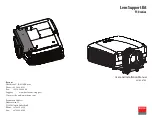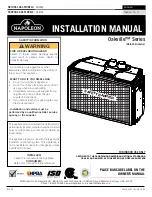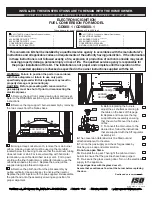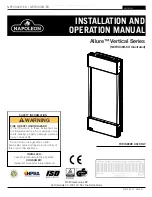FS-9100OM
– REV B
4
Copyright 2020 Baker Hughes Holdings LLC. All rights reserved
1.3 GENERAL DESCRIPTION
The Flame Tracker Lite is a rugged flame sensor that can operate in harsh industrial applications. The Reuter-
Stokes technology has millions of operating hours and very high reliability. The sensor has high sensitivity and
is tailored for use with hydrocarbon flames. It uses a silicon carbide sensing element for UV detection and has
a single 4-20 mA current loop output. The Flame Tracker Lite can operate under high temperature and pressure
and is constructed of corrosion resistant material. The sensor body is sealed and filled with dry argon.
The sensor circuit has a high initial gain, which automatically shifts to a lower gain in order to accommodate
a wide range of input light level without saturating. The sensor regulates the supply current in proportion to the
amount of UV light present. Both power and signal are transmitted on the same two wires. The sensor can be
powered from a dc voltage between 12 and 30 volts.
The maximum operating temperature for the flame sensor is 120
C (248
F). Cooling systems are not
applicable.
2
INSTALLATION
2.1 MECHANICAL
Mount the Flame Tracker Lite on a sight tube with 1” NPT male threads. Ensure that the sight tube has an
unobstructed view of the flame. The sight tube should be adjusted to maximize the view of the flame. The line
of sight for the sensor should be at a shallow angle to the burner center line and should pass through the primary
combustion zone of the flame.
In order to reduce the risk of galling, use an anti seize compound on the sight tube threads. Be sure the
amount is minimal and only applied below the 2
nd
thread. If anti-sieze compound is applied to the face of the
sight tube, upon heating, it can fog the window of the Flame Tracker Lite.
Inspect the sensor window and, if necessary, clean with an isopropanol soaked swab. Hand tighten then
tighten with a 1 5/8” wrench approximately 2.5 turns. To connect the cable, align keys on cable connector with
slots in sensor connector. Tighten the connector by turning the knurled ring of the connector until the red line is
hidden.
Although purge air for cooling is not generally required, purge air to prevent contamination on the sensor
window is necessary. Any contamination that deposits on the sensor window will decrease the amount of UV
light that enters the sensor and decrease the output of the sensor. Use a Y or T fitting to introduce purge air into
the sight tube. Ensure that the pressure and flow rate are sufficient to flow air down the sight tube and away from
the flame sensor.
2.2 ELECTRICAL
The sensors can be connected directly to the control system or it can be connected to a junction box and then
to the control system. An interconnect cable RS-E2-0285PXXX or equivalent is used to connect to the sensor.
The RS-E2-0285PXXX consists of black, white and green wires twisted and shielded. All wiring must be in
grounded conduit except the armored sections of the interconnect cables.The green wire must be connected to
earth ground at the junction box, if one exists. If no junction box is used and the cable is run directly to the control
system, do not connect the green wire to anything. Do not connect the shields to each other or to earth ground
at any location. The shields should be individually jumped through all junction boxes and connected to the
proper ground terminal at the Controller.
The polarity of the cable is as follows: white is positive and black is negative/signal return. Reverse polarity
will not damage the sensor, however the sensor will not function connected this way. If a junction box is used,
the signal cable from the junction box to the control system should be 18 gauge (1.02 mm) twisted shielded pair.
See Figure 1.
Figure 1 shows the preferred wiring for the sensor with the R
sense
of the control system in the return line of the
sensor. This configuration can be used with control systems that have single ended inputs (one side of the input


















